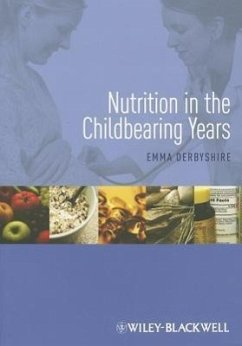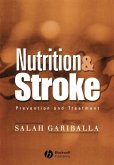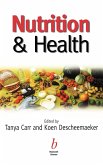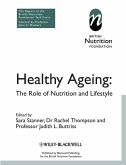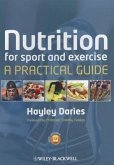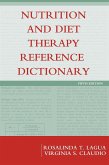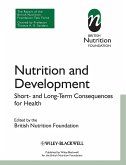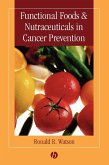Emma Derbyshire
Nutrition in the Childbearing Years
Emma Derbyshire
Nutrition in the Childbearing Years
- Broschiertes Buch
- Merkliste
- Auf die Merkliste
- Bewerten Bewerten
- Teilen
- Produkt teilen
- Produkterinnerung
- Produkterinnerung
In a field saturated with complex and conflicting information, this exciting new book covers information about nutrition before, during and after pregnancy in a clear and user friendly style. The author addresses all the major aspects of the subject, moving from fertility and preparing the body for pregnancy, through to nutrient metabolism, diet and pregnancy outcome, weight gain, special needs, and postpartum changes and nutrition. This guide's evidence based approach will appeal to nutritionists and dietitians, and to many other health professionals who work with women in their childbearing…mehr
Andere Kunden interessierten sich auch für
![Nutrition and Stroke Prevention Treatmnt Nutrition and Stroke Prevention Treatmnt]() Salah GariballaNutrition and Stroke Prevention Treatmnt127,99 €
Salah GariballaNutrition and Stroke Prevention Treatmnt127,99 €![Nutrition and Health Nutrition and Health]() Nutrition and Health212,99 €
Nutrition and Health212,99 €![Healthy Ageing Healthy Ageing]() Bnf (British Nutrition Foundation)Healthy Ageing130,99 €
Bnf (British Nutrition Foundation)Healthy Ageing130,99 €![Nutrition for Sport and Exercise Nutrition for Sport and Exercise]() Hayley DariesNutrition for Sport and Exercise70,99 €
Hayley DariesNutrition for Sport and Exercise70,99 €![Nutrition and Diet Therapy Reference Dictionary Nutrition and Diet Therapy Reference Dictionary]() Rosalinda T LaguaNutrition and Diet Therapy Reference Dictionary123,99 €
Rosalinda T LaguaNutrition and Diet Therapy Reference Dictionary123,99 €![Nutrition and Development Nutrition and Development]() Bnf (British Nutrition Foundation)Nutrition and Development100,99 €
Bnf (British Nutrition Foundation)Nutrition and Development100,99 €![Function Foods and Nutraceutics Cancer Function Foods and Nutraceutics Cancer]() Ronald R Watson (ed.)Function Foods and Nutraceutics Cancer281,99 €
Ronald R Watson (ed.)Function Foods and Nutraceutics Cancer281,99 €-
-
-
In a field saturated with complex and conflicting information, this exciting new book covers information about nutrition before, during and after pregnancy in a clear and user friendly style. The author addresses all the major aspects of the subject, moving from fertility and preparing the body for pregnancy, through to nutrient metabolism, diet and pregnancy outcome, weight gain, special needs, and postpartum changes and nutrition. This guide's evidence based approach will appeal to nutritionists and dietitians, and to many other health professionals who work with women in their childbearing years, including midwives, nurses and family practioners. Each chapter includes a useful set of appendices covering dietary requirements, nutritional composition of key foods and weight gain guidelines, as well as application in practice sections and a summary of key points.
Hinweis: Dieser Artikel kann nur an eine deutsche Lieferadresse ausgeliefert werden.
Hinweis: Dieser Artikel kann nur an eine deutsche Lieferadresse ausgeliefert werden.
Produktdetails
- Produktdetails
- Verlag: Wiley
- Seitenzahl: 350
- Erscheinungstermin: 7. November 2011
- Englisch
- Abmessung: 241mm x 173mm x 20mm
- Gewicht: 726g
- ISBN-13: 9781444333053
- ISBN-10: 1444333054
- Artikelnr.: 33937296
- Herstellerkennzeichnung
- Libri GmbH
- Europaallee 1
- 36244 Bad Hersfeld
- gpsr@libri.de
- Verlag: Wiley
- Seitenzahl: 350
- Erscheinungstermin: 7. November 2011
- Englisch
- Abmessung: 241mm x 173mm x 20mm
- Gewicht: 726g
- ISBN-13: 9781444333053
- ISBN-10: 1444333054
- Artikelnr.: 33937296
- Herstellerkennzeichnung
- Libri GmbH
- Europaallee 1
- 36244 Bad Hersfeld
- gpsr@libri.de
Emma Derbyshire is Senior Lecturer and Researcher?in Human Nutrition at Manchester Metropolitan University.
Foreword xi
Preface xvii
Dedication xviii
Acknowledgements xix
Glossary xx
1 Nutrition and Fertility 1
1.1 Introduction 1
1.2 Nutrition and female fertility 2
1.3 Nutrition and male fertility 12
1.4 Conclusion 20
2 Preparing the Body for Pregnancy 25
2.1 Introduction 26
2.2 Nutrient stores 26
2.3 Body weight before pregnancy 28
2.4 The importance of a balanced diet 29
2.5 What are women eating? 29
2.6 A note on dietary recommendations 30
2.7 Compliance with current recommendations 31
2.8 A focus on alcohol 33
2.9 A focus on caffeine 33
2.10 A focus on calcium 34
2.11 A focus on folate 34
2.12 A focus on iron 36
2.13 Emerging interest in choline 38
2.14 Multivitamin and mineral supplements 38
2.15 Application in practice 39
2.16 Food safety 39
2.17 Vitamin A 41
2.18 Fish consumption 41
2.19 Peanut allergy 42
2.20 Food additives and ingredients 43
2.21 Organic food 43
2.22 Other concerns 43
2.23 Application in practice 44
2.24 Conclusion 44
3 Hormonal and Physiological Changes 50
3.1 Introduction 50
3.2 Before conception 51
3.3 After conception 52
3.4 Formation of the neural tube 55
3.5 Foetal growth 56
3.6 Key hormones 57
3.7 Key physiological changes 61
3.8 Conclusion 69
4 Nutrient Metabolism in Pregnancy 74
4.1 Introduction 74
4.2 Energy metabolism 75
4.3 Carbohydrate metabolism 78
4.4 Lipid metabolism 80
4.5 Protein metabolism 83
4.6 Calcium metabolism 84
4.7 Vitamin D metabolism 87
4.8 Iron metabolism 89
4.9 Folic acid versus folate 92
4.10 Conclusion 95
5 Macronutrients and Pregnancy 100
5.1 Introduction 100
5.2 Food cravings and aversions 101
5.3 Energy 102
5.4 Carbohydrate 104
5.5 Sugar 106
5.6 Protein 107
5.7 Fat 109
5.8 Fibre 111
5.9 Water 113
5.10 Dairy products 114
5.11 Salt 116
5.12 Application in practice 116
5.13 Food choices 117
5.14 Dietary assessment 118
5.15 Diet quality index 119
5.16 Biomarkers 119
5.17 Application in practice 120
5.18 Conclusion 120
6 Vitamins and Pregnancy 126
6.1 Introduction 126
6.2 Vitamin A 127
6.3 Thiamine (vitamin B1) 129
6.4 Riboflavin (vitamin B2) 130
6.5 Niacin (vitamin B3) 130
6.6 Pantothenic acid (B5) 130
6.7 Pyridoxine (B6) 130
6.8 Biotin 131
6.9 Cobalamin (B12) 132
6.10 Folate 133
6.11 Choline 137
6.12 Vitamin C 138
6.13 Vitamin D 140
6.14 Vitamin E 141
6.15 Vitamin K 142
6.16 Combined vitamin deficiencies 142
6.17 Supplements and pregnancy 143
6.18 Application in practice 143
6.19 Conclusion 144
7 Minerals and Pregnancy 149
7.1 Introduction 149
7.2 Macrominerals 150
7.3 Microminerals 153
7.4 Application in practice 162
7.5 Conclusion 162
8 Diet and Pregnancy Outcome 168
8.1 Introduction 168
8.2 What is a 'healthy' baby? 169
8.3 A note on Apgar scores 170
8.4 What is foetal growth restriction? 170
8.5 Poor pregnancy outcomes 170
8.6 Sensitive windows of pregnancy 171
8.7 Alcohol 172
8.8 Caffeine 174
8.9 Dietary mutagens 178
8.10 Pesticides 182
8.11 Hypospadias 182
8.12 Nutrigenomics 183
8.13 Foetal origins of adult disease 185
8.14 Supplements 187
8.15 Application in practice 190
8.16 Conclusion 190
9 Weight Gain in Pregnancy 195
9.1 Introduction 195
9.2 Body weight before pregnancy 196
9.3 Weight gain - how much and when? 198
9.4 Components of weight gain 199
9.5 Proportions of pregnancy weight gain 199
9.6 Measuring body composition in pregnancy 200
9.7 High pregnancy weight gain 203
9.8 Low pregnancy weight gain 207
9.9 Weight gain guidelines 209
9.10 Multiple foetuses 210
9.11 Weight retention 210
9.12 Weight loss interventions 211
9.13 What about physical activity? 211
9.14 A note on weight management 212
9.15 Application in practice 212
9.16 Conclusion 213
10 Special Cases 218
10.1 Introduction 218
10.2 Pregnant adolescents 219
10.3 Advanced maternal age 223
10.4 Multifoetal pregnancies 224
10.5 Maternal obesity 227
10.6 Diabetic mothers 228
10.7 Phenylketonuria (PKU) in pregnancy 230
10.8 Vegetarian mothers 231
10.9 Alternative dietary practices 232
10.10 Nutrition and culture 234
10.11 Conclusion 235
11 Physiological and Hormonal Changes after Birth 241
11.1 Introduction 241
11.2 When is 'postpartum'? 242
11.3 Changes after birth 242
11.4 Lactogenesis 247
11.5 A note on colostrum 251
11.6 What is transitional milk? 251
11.7 Nutritional composition of milk 251
11.8 Milk synthesis - use it or lose it 252
11.9 Milk volume 253
11.10 Breastfeeding as contraception 254
11.11 Breast cancer risk 254
11.12 Body weight after birth 254
11.13 Breastfeeding and body weight 255
11.14 Body composition changes 256
11.15 Exercise and breastfeeding 256
11.16 Weight loss interventions 257
11.17 Conclusion 257
12 Nutrition after Birth 262
12.1 Introduction 262
12.2 Is breast best? 263
12.3 What's in breast milk? 264
12.4 Breastfeeding - for how long? 264
12.5 Who is breastfeeding? 266
12.6 Infant feeding survey 267
12.7 Why do women stop breastfeeding? 267
12.8 Feeding and infant growth 269
12.9 Dietary requirements after birth 269
12.10 Vegetarian and vegan mothers 276
12.11 Feeding multiples 276
12.12 Allergy risk 276
12.13 Postnatal depression 277
12.14 Supplement use after birth 279
12.15 Healthy eating from an early age 280
12.16 Application in practice 280
12.17 Conclusion 281
APPENDICES.
Appendix 1 International definitions of indices used to form dietary
recommendations 289
Appendix 2 Recommended nutrient intakes for women of childbearing age
(19-50 years) 290
Appendix 3 Recommended nutrient intakes for pregnancy 292
Appendix 4 Recommended nutrient intakes for breastfeeding mothers 293
Appendix 5 Recommended nutrient intakes for pregnant and lactating
adolescents (14-18 years) 294
Appendix 6 Suggested nutritional recommendations for twin pregnancies 295
Appendix 7 Tolerable upper intake levels (ULs) for vitamins and minerals
296
Appendix 8 Institute of Medicine pregnancy weight gain guidelines 297
Appendix 9 Examples of common food safety concerns 298
References 301
CASE STUDIES
Planning a pregnancy 305
Older mother 307
Multifetal pregnancy 308
Teenage mother 310
Vegetarian mother 311
Breastfeeding mother 313
Overweight mother 314
Index 315
Preface xvii
Dedication xviii
Acknowledgements xix
Glossary xx
1 Nutrition and Fertility 1
1.1 Introduction 1
1.2 Nutrition and female fertility 2
1.3 Nutrition and male fertility 12
1.4 Conclusion 20
2 Preparing the Body for Pregnancy 25
2.1 Introduction 26
2.2 Nutrient stores 26
2.3 Body weight before pregnancy 28
2.4 The importance of a balanced diet 29
2.5 What are women eating? 29
2.6 A note on dietary recommendations 30
2.7 Compliance with current recommendations 31
2.8 A focus on alcohol 33
2.9 A focus on caffeine 33
2.10 A focus on calcium 34
2.11 A focus on folate 34
2.12 A focus on iron 36
2.13 Emerging interest in choline 38
2.14 Multivitamin and mineral supplements 38
2.15 Application in practice 39
2.16 Food safety 39
2.17 Vitamin A 41
2.18 Fish consumption 41
2.19 Peanut allergy 42
2.20 Food additives and ingredients 43
2.21 Organic food 43
2.22 Other concerns 43
2.23 Application in practice 44
2.24 Conclusion 44
3 Hormonal and Physiological Changes 50
3.1 Introduction 50
3.2 Before conception 51
3.3 After conception 52
3.4 Formation of the neural tube 55
3.5 Foetal growth 56
3.6 Key hormones 57
3.7 Key physiological changes 61
3.8 Conclusion 69
4 Nutrient Metabolism in Pregnancy 74
4.1 Introduction 74
4.2 Energy metabolism 75
4.3 Carbohydrate metabolism 78
4.4 Lipid metabolism 80
4.5 Protein metabolism 83
4.6 Calcium metabolism 84
4.7 Vitamin D metabolism 87
4.8 Iron metabolism 89
4.9 Folic acid versus folate 92
4.10 Conclusion 95
5 Macronutrients and Pregnancy 100
5.1 Introduction 100
5.2 Food cravings and aversions 101
5.3 Energy 102
5.4 Carbohydrate 104
5.5 Sugar 106
5.6 Protein 107
5.7 Fat 109
5.8 Fibre 111
5.9 Water 113
5.10 Dairy products 114
5.11 Salt 116
5.12 Application in practice 116
5.13 Food choices 117
5.14 Dietary assessment 118
5.15 Diet quality index 119
5.16 Biomarkers 119
5.17 Application in practice 120
5.18 Conclusion 120
6 Vitamins and Pregnancy 126
6.1 Introduction 126
6.2 Vitamin A 127
6.3 Thiamine (vitamin B1) 129
6.4 Riboflavin (vitamin B2) 130
6.5 Niacin (vitamin B3) 130
6.6 Pantothenic acid (B5) 130
6.7 Pyridoxine (B6) 130
6.8 Biotin 131
6.9 Cobalamin (B12) 132
6.10 Folate 133
6.11 Choline 137
6.12 Vitamin C 138
6.13 Vitamin D 140
6.14 Vitamin E 141
6.15 Vitamin K 142
6.16 Combined vitamin deficiencies 142
6.17 Supplements and pregnancy 143
6.18 Application in practice 143
6.19 Conclusion 144
7 Minerals and Pregnancy 149
7.1 Introduction 149
7.2 Macrominerals 150
7.3 Microminerals 153
7.4 Application in practice 162
7.5 Conclusion 162
8 Diet and Pregnancy Outcome 168
8.1 Introduction 168
8.2 What is a 'healthy' baby? 169
8.3 A note on Apgar scores 170
8.4 What is foetal growth restriction? 170
8.5 Poor pregnancy outcomes 170
8.6 Sensitive windows of pregnancy 171
8.7 Alcohol 172
8.8 Caffeine 174
8.9 Dietary mutagens 178
8.10 Pesticides 182
8.11 Hypospadias 182
8.12 Nutrigenomics 183
8.13 Foetal origins of adult disease 185
8.14 Supplements 187
8.15 Application in practice 190
8.16 Conclusion 190
9 Weight Gain in Pregnancy 195
9.1 Introduction 195
9.2 Body weight before pregnancy 196
9.3 Weight gain - how much and when? 198
9.4 Components of weight gain 199
9.5 Proportions of pregnancy weight gain 199
9.6 Measuring body composition in pregnancy 200
9.7 High pregnancy weight gain 203
9.8 Low pregnancy weight gain 207
9.9 Weight gain guidelines 209
9.10 Multiple foetuses 210
9.11 Weight retention 210
9.12 Weight loss interventions 211
9.13 What about physical activity? 211
9.14 A note on weight management 212
9.15 Application in practice 212
9.16 Conclusion 213
10 Special Cases 218
10.1 Introduction 218
10.2 Pregnant adolescents 219
10.3 Advanced maternal age 223
10.4 Multifoetal pregnancies 224
10.5 Maternal obesity 227
10.6 Diabetic mothers 228
10.7 Phenylketonuria (PKU) in pregnancy 230
10.8 Vegetarian mothers 231
10.9 Alternative dietary practices 232
10.10 Nutrition and culture 234
10.11 Conclusion 235
11 Physiological and Hormonal Changes after Birth 241
11.1 Introduction 241
11.2 When is 'postpartum'? 242
11.3 Changes after birth 242
11.4 Lactogenesis 247
11.5 A note on colostrum 251
11.6 What is transitional milk? 251
11.7 Nutritional composition of milk 251
11.8 Milk synthesis - use it or lose it 252
11.9 Milk volume 253
11.10 Breastfeeding as contraception 254
11.11 Breast cancer risk 254
11.12 Body weight after birth 254
11.13 Breastfeeding and body weight 255
11.14 Body composition changes 256
11.15 Exercise and breastfeeding 256
11.16 Weight loss interventions 257
11.17 Conclusion 257
12 Nutrition after Birth 262
12.1 Introduction 262
12.2 Is breast best? 263
12.3 What's in breast milk? 264
12.4 Breastfeeding - for how long? 264
12.5 Who is breastfeeding? 266
12.6 Infant feeding survey 267
12.7 Why do women stop breastfeeding? 267
12.8 Feeding and infant growth 269
12.9 Dietary requirements after birth 269
12.10 Vegetarian and vegan mothers 276
12.11 Feeding multiples 276
12.12 Allergy risk 276
12.13 Postnatal depression 277
12.14 Supplement use after birth 279
12.15 Healthy eating from an early age 280
12.16 Application in practice 280
12.17 Conclusion 281
APPENDICES.
Appendix 1 International definitions of indices used to form dietary
recommendations 289
Appendix 2 Recommended nutrient intakes for women of childbearing age
(19-50 years) 290
Appendix 3 Recommended nutrient intakes for pregnancy 292
Appendix 4 Recommended nutrient intakes for breastfeeding mothers 293
Appendix 5 Recommended nutrient intakes for pregnant and lactating
adolescents (14-18 years) 294
Appendix 6 Suggested nutritional recommendations for twin pregnancies 295
Appendix 7 Tolerable upper intake levels (ULs) for vitamins and minerals
296
Appendix 8 Institute of Medicine pregnancy weight gain guidelines 297
Appendix 9 Examples of common food safety concerns 298
References 301
CASE STUDIES
Planning a pregnancy 305
Older mother 307
Multifetal pregnancy 308
Teenage mother 310
Vegetarian mother 311
Breastfeeding mother 313
Overweight mother 314
Index 315
Foreword xi
Preface xvii
Dedication xviii
Acknowledgements xix
Glossary xx
1 Nutrition and Fertility 1
1.1 Introduction 1
1.2 Nutrition and female fertility 2
1.3 Nutrition and male fertility 12
1.4 Conclusion 20
2 Preparing the Body for Pregnancy 25
2.1 Introduction 26
2.2 Nutrient stores 26
2.3 Body weight before pregnancy 28
2.4 The importance of a balanced diet 29
2.5 What are women eating? 29
2.6 A note on dietary recommendations 30
2.7 Compliance with current recommendations 31
2.8 A focus on alcohol 33
2.9 A focus on caffeine 33
2.10 A focus on calcium 34
2.11 A focus on folate 34
2.12 A focus on iron 36
2.13 Emerging interest in choline 38
2.14 Multivitamin and mineral supplements 38
2.15 Application in practice 39
2.16 Food safety 39
2.17 Vitamin A 41
2.18 Fish consumption 41
2.19 Peanut allergy 42
2.20 Food additives and ingredients 43
2.21 Organic food 43
2.22 Other concerns 43
2.23 Application in practice 44
2.24 Conclusion 44
3 Hormonal and Physiological Changes 50
3.1 Introduction 50
3.2 Before conception 51
3.3 After conception 52
3.4 Formation of the neural tube 55
3.5 Foetal growth 56
3.6 Key hormones 57
3.7 Key physiological changes 61
3.8 Conclusion 69
4 Nutrient Metabolism in Pregnancy 74
4.1 Introduction 74
4.2 Energy metabolism 75
4.3 Carbohydrate metabolism 78
4.4 Lipid metabolism 80
4.5 Protein metabolism 83
4.6 Calcium metabolism 84
4.7 Vitamin D metabolism 87
4.8 Iron metabolism 89
4.9 Folic acid versus folate 92
4.10 Conclusion 95
5 Macronutrients and Pregnancy 100
5.1 Introduction 100
5.2 Food cravings and aversions 101
5.3 Energy 102
5.4 Carbohydrate 104
5.5 Sugar 106
5.6 Protein 107
5.7 Fat 109
5.8 Fibre 111
5.9 Water 113
5.10 Dairy products 114
5.11 Salt 116
5.12 Application in practice 116
5.13 Food choices 117
5.14 Dietary assessment 118
5.15 Diet quality index 119
5.16 Biomarkers 119
5.17 Application in practice 120
5.18 Conclusion 120
6 Vitamins and Pregnancy 126
6.1 Introduction 126
6.2 Vitamin A 127
6.3 Thiamine (vitamin B1) 129
6.4 Riboflavin (vitamin B2) 130
6.5 Niacin (vitamin B3) 130
6.6 Pantothenic acid (B5) 130
6.7 Pyridoxine (B6) 130
6.8 Biotin 131
6.9 Cobalamin (B12) 132
6.10 Folate 133
6.11 Choline 137
6.12 Vitamin C 138
6.13 Vitamin D 140
6.14 Vitamin E 141
6.15 Vitamin K 142
6.16 Combined vitamin deficiencies 142
6.17 Supplements and pregnancy 143
6.18 Application in practice 143
6.19 Conclusion 144
7 Minerals and Pregnancy 149
7.1 Introduction 149
7.2 Macrominerals 150
7.3 Microminerals 153
7.4 Application in practice 162
7.5 Conclusion 162
8 Diet and Pregnancy Outcome 168
8.1 Introduction 168
8.2 What is a 'healthy' baby? 169
8.3 A note on Apgar scores 170
8.4 What is foetal growth restriction? 170
8.5 Poor pregnancy outcomes 170
8.6 Sensitive windows of pregnancy 171
8.7 Alcohol 172
8.8 Caffeine 174
8.9 Dietary mutagens 178
8.10 Pesticides 182
8.11 Hypospadias 182
8.12 Nutrigenomics 183
8.13 Foetal origins of adult disease 185
8.14 Supplements 187
8.15 Application in practice 190
8.16 Conclusion 190
9 Weight Gain in Pregnancy 195
9.1 Introduction 195
9.2 Body weight before pregnancy 196
9.3 Weight gain - how much and when? 198
9.4 Components of weight gain 199
9.5 Proportions of pregnancy weight gain 199
9.6 Measuring body composition in pregnancy 200
9.7 High pregnancy weight gain 203
9.8 Low pregnancy weight gain 207
9.9 Weight gain guidelines 209
9.10 Multiple foetuses 210
9.11 Weight retention 210
9.12 Weight loss interventions 211
9.13 What about physical activity? 211
9.14 A note on weight management 212
9.15 Application in practice 212
9.16 Conclusion 213
10 Special Cases 218
10.1 Introduction 218
10.2 Pregnant adolescents 219
10.3 Advanced maternal age 223
10.4 Multifoetal pregnancies 224
10.5 Maternal obesity 227
10.6 Diabetic mothers 228
10.7 Phenylketonuria (PKU) in pregnancy 230
10.8 Vegetarian mothers 231
10.9 Alternative dietary practices 232
10.10 Nutrition and culture 234
10.11 Conclusion 235
11 Physiological and Hormonal Changes after Birth 241
11.1 Introduction 241
11.2 When is 'postpartum'? 242
11.3 Changes after birth 242
11.4 Lactogenesis 247
11.5 A note on colostrum 251
11.6 What is transitional milk? 251
11.7 Nutritional composition of milk 251
11.8 Milk synthesis - use it or lose it 252
11.9 Milk volume 253
11.10 Breastfeeding as contraception 254
11.11 Breast cancer risk 254
11.12 Body weight after birth 254
11.13 Breastfeeding and body weight 255
11.14 Body composition changes 256
11.15 Exercise and breastfeeding 256
11.16 Weight loss interventions 257
11.17 Conclusion 257
12 Nutrition after Birth 262
12.1 Introduction 262
12.2 Is breast best? 263
12.3 What's in breast milk? 264
12.4 Breastfeeding - for how long? 264
12.5 Who is breastfeeding? 266
12.6 Infant feeding survey 267
12.7 Why do women stop breastfeeding? 267
12.8 Feeding and infant growth 269
12.9 Dietary requirements after birth 269
12.10 Vegetarian and vegan mothers 276
12.11 Feeding multiples 276
12.12 Allergy risk 276
12.13 Postnatal depression 277
12.14 Supplement use after birth 279
12.15 Healthy eating from an early age 280
12.16 Application in practice 280
12.17 Conclusion 281
APPENDICES.
Appendix 1 International definitions of indices used to form dietary
recommendations 289
Appendix 2 Recommended nutrient intakes for women of childbearing age
(19-50 years) 290
Appendix 3 Recommended nutrient intakes for pregnancy 292
Appendix 4 Recommended nutrient intakes for breastfeeding mothers 293
Appendix 5 Recommended nutrient intakes for pregnant and lactating
adolescents (14-18 years) 294
Appendix 6 Suggested nutritional recommendations for twin pregnancies 295
Appendix 7 Tolerable upper intake levels (ULs) for vitamins and minerals
296
Appendix 8 Institute of Medicine pregnancy weight gain guidelines 297
Appendix 9 Examples of common food safety concerns 298
References 301
CASE STUDIES
Planning a pregnancy 305
Older mother 307
Multifetal pregnancy 308
Teenage mother 310
Vegetarian mother 311
Breastfeeding mother 313
Overweight mother 314
Index 315
Preface xvii
Dedication xviii
Acknowledgements xix
Glossary xx
1 Nutrition and Fertility 1
1.1 Introduction 1
1.2 Nutrition and female fertility 2
1.3 Nutrition and male fertility 12
1.4 Conclusion 20
2 Preparing the Body for Pregnancy 25
2.1 Introduction 26
2.2 Nutrient stores 26
2.3 Body weight before pregnancy 28
2.4 The importance of a balanced diet 29
2.5 What are women eating? 29
2.6 A note on dietary recommendations 30
2.7 Compliance with current recommendations 31
2.8 A focus on alcohol 33
2.9 A focus on caffeine 33
2.10 A focus on calcium 34
2.11 A focus on folate 34
2.12 A focus on iron 36
2.13 Emerging interest in choline 38
2.14 Multivitamin and mineral supplements 38
2.15 Application in practice 39
2.16 Food safety 39
2.17 Vitamin A 41
2.18 Fish consumption 41
2.19 Peanut allergy 42
2.20 Food additives and ingredients 43
2.21 Organic food 43
2.22 Other concerns 43
2.23 Application in practice 44
2.24 Conclusion 44
3 Hormonal and Physiological Changes 50
3.1 Introduction 50
3.2 Before conception 51
3.3 After conception 52
3.4 Formation of the neural tube 55
3.5 Foetal growth 56
3.6 Key hormones 57
3.7 Key physiological changes 61
3.8 Conclusion 69
4 Nutrient Metabolism in Pregnancy 74
4.1 Introduction 74
4.2 Energy metabolism 75
4.3 Carbohydrate metabolism 78
4.4 Lipid metabolism 80
4.5 Protein metabolism 83
4.6 Calcium metabolism 84
4.7 Vitamin D metabolism 87
4.8 Iron metabolism 89
4.9 Folic acid versus folate 92
4.10 Conclusion 95
5 Macronutrients and Pregnancy 100
5.1 Introduction 100
5.2 Food cravings and aversions 101
5.3 Energy 102
5.4 Carbohydrate 104
5.5 Sugar 106
5.6 Protein 107
5.7 Fat 109
5.8 Fibre 111
5.9 Water 113
5.10 Dairy products 114
5.11 Salt 116
5.12 Application in practice 116
5.13 Food choices 117
5.14 Dietary assessment 118
5.15 Diet quality index 119
5.16 Biomarkers 119
5.17 Application in practice 120
5.18 Conclusion 120
6 Vitamins and Pregnancy 126
6.1 Introduction 126
6.2 Vitamin A 127
6.3 Thiamine (vitamin B1) 129
6.4 Riboflavin (vitamin B2) 130
6.5 Niacin (vitamin B3) 130
6.6 Pantothenic acid (B5) 130
6.7 Pyridoxine (B6) 130
6.8 Biotin 131
6.9 Cobalamin (B12) 132
6.10 Folate 133
6.11 Choline 137
6.12 Vitamin C 138
6.13 Vitamin D 140
6.14 Vitamin E 141
6.15 Vitamin K 142
6.16 Combined vitamin deficiencies 142
6.17 Supplements and pregnancy 143
6.18 Application in practice 143
6.19 Conclusion 144
7 Minerals and Pregnancy 149
7.1 Introduction 149
7.2 Macrominerals 150
7.3 Microminerals 153
7.4 Application in practice 162
7.5 Conclusion 162
8 Diet and Pregnancy Outcome 168
8.1 Introduction 168
8.2 What is a 'healthy' baby? 169
8.3 A note on Apgar scores 170
8.4 What is foetal growth restriction? 170
8.5 Poor pregnancy outcomes 170
8.6 Sensitive windows of pregnancy 171
8.7 Alcohol 172
8.8 Caffeine 174
8.9 Dietary mutagens 178
8.10 Pesticides 182
8.11 Hypospadias 182
8.12 Nutrigenomics 183
8.13 Foetal origins of adult disease 185
8.14 Supplements 187
8.15 Application in practice 190
8.16 Conclusion 190
9 Weight Gain in Pregnancy 195
9.1 Introduction 195
9.2 Body weight before pregnancy 196
9.3 Weight gain - how much and when? 198
9.4 Components of weight gain 199
9.5 Proportions of pregnancy weight gain 199
9.6 Measuring body composition in pregnancy 200
9.7 High pregnancy weight gain 203
9.8 Low pregnancy weight gain 207
9.9 Weight gain guidelines 209
9.10 Multiple foetuses 210
9.11 Weight retention 210
9.12 Weight loss interventions 211
9.13 What about physical activity? 211
9.14 A note on weight management 212
9.15 Application in practice 212
9.16 Conclusion 213
10 Special Cases 218
10.1 Introduction 218
10.2 Pregnant adolescents 219
10.3 Advanced maternal age 223
10.4 Multifoetal pregnancies 224
10.5 Maternal obesity 227
10.6 Diabetic mothers 228
10.7 Phenylketonuria (PKU) in pregnancy 230
10.8 Vegetarian mothers 231
10.9 Alternative dietary practices 232
10.10 Nutrition and culture 234
10.11 Conclusion 235
11 Physiological and Hormonal Changes after Birth 241
11.1 Introduction 241
11.2 When is 'postpartum'? 242
11.3 Changes after birth 242
11.4 Lactogenesis 247
11.5 A note on colostrum 251
11.6 What is transitional milk? 251
11.7 Nutritional composition of milk 251
11.8 Milk synthesis - use it or lose it 252
11.9 Milk volume 253
11.10 Breastfeeding as contraception 254
11.11 Breast cancer risk 254
11.12 Body weight after birth 254
11.13 Breastfeeding and body weight 255
11.14 Body composition changes 256
11.15 Exercise and breastfeeding 256
11.16 Weight loss interventions 257
11.17 Conclusion 257
12 Nutrition after Birth 262
12.1 Introduction 262
12.2 Is breast best? 263
12.3 What's in breast milk? 264
12.4 Breastfeeding - for how long? 264
12.5 Who is breastfeeding? 266
12.6 Infant feeding survey 267
12.7 Why do women stop breastfeeding? 267
12.8 Feeding and infant growth 269
12.9 Dietary requirements after birth 269
12.10 Vegetarian and vegan mothers 276
12.11 Feeding multiples 276
12.12 Allergy risk 276
12.13 Postnatal depression 277
12.14 Supplement use after birth 279
12.15 Healthy eating from an early age 280
12.16 Application in practice 280
12.17 Conclusion 281
APPENDICES.
Appendix 1 International definitions of indices used to form dietary
recommendations 289
Appendix 2 Recommended nutrient intakes for women of childbearing age
(19-50 years) 290
Appendix 3 Recommended nutrient intakes for pregnancy 292
Appendix 4 Recommended nutrient intakes for breastfeeding mothers 293
Appendix 5 Recommended nutrient intakes for pregnant and lactating
adolescents (14-18 years) 294
Appendix 6 Suggested nutritional recommendations for twin pregnancies 295
Appendix 7 Tolerable upper intake levels (ULs) for vitamins and minerals
296
Appendix 8 Institute of Medicine pregnancy weight gain guidelines 297
Appendix 9 Examples of common food safety concerns 298
References 301
CASE STUDIES
Planning a pregnancy 305
Older mother 307
Multifetal pregnancy 308
Teenage mother 310
Vegetarian mother 311
Breastfeeding mother 313
Overweight mother 314
Index 315

